 W
WAjtony, Ahtum or Achtum was an early-11th-century ruler in the territory now known as Banat in present Romania and Serbia. His primary source is the Long Life of Saint Gerard, a 14th-century hagiography. Ajtony was a powerful ruler who owned many horses, cattle and sheep and was baptised according to the Orthodox rite in Vidin. He taxed salt which was transferred to King Stephen I of Hungary on the Mureș River. The king sent Csanád, Ajtony's former commander-in-chief, against him at the head of a large army. Csanád defeated and killed Ajtony, occupying his realm. In the territory, at least one county and a Roman Catholic diocese were established.
 W
WÁlmos was a Hungarian prince, the son of King Géza I of Hungary and brother of King Coloman. He held several governmental posts in the Kingdom of Hungary.
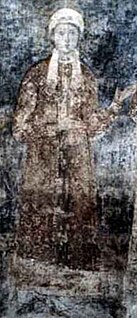 W
WAnastasia of Kiev was Queen of Hungary by marriage to King Andrew the White. She was the eldest daughter of Grand Prince Yaroslav I the Wise of Kiev and Ingigerd of Sweden, and the older sister of Anne of Kiev, Queen consort of Henry I of France.
 W
WAndrew I the White or the Catholic was King of Hungary from 1046 to 1060. He descended from a younger branch of the Árpád dynasty. After spending fifteen years in exile, he ascended the throne during an extensive revolt of the pagan Hungarians. He strengthened the position of Christianity in the Kingdom of Hungary and successfully defended its independence against the Holy Roman Empire.
 W
WSaint Astrik of Pannonhalma is a saint of the 11th century.
 W
WBartolf also known as Bartholomew was a Scottish and Hungarian nobleman and the founder of the Leslie family, who currently serve as Earls of Leven and Earls of Rothes and Lord Newark, all of which are situated in the historic kingdom of Scotland. He came over from Hungary in 1067 with Margaret later St Margaret of Scotland.
 W
WBéla I the Boxer or the Wisent was King of Hungary from 1060 until his death. He descended from a younger branch of the Árpád dynasty. Béla's baptismal name was Adalbert. He left Hungary in 1031, together with his brothers, Levente and Andrew, after the execution of their father, Vazul. Béla settled in Poland and married Richeza, daughter of King Mieszko II of Poland.
 W
WBenedict of Skalka or Szkalka, born Stojislav in Nitra, Hungarian Kingdom, was a Benedictine monk, now venerated as a saint. He became a hermit and lived an austere life in a cave along the Vah River. Benedict was strangled to death in 1012 by a gang of robbers looking for treasure. He is venerated in Slovakia, Hungary, Poland and the emigrant diasporas in the United States.
 W
WColoman the Learned, also the Book-Lover or the Bookish was King of Hungary from 1095 and King of Croatia from 1097 until his death. Because Coloman and his younger brother Álmos were underage when their father Géza I died, their uncle Ladislaus I ascended the throne in 1077. Ladislaus prepared Coloman—who was "half-blind and humpbacked", according to late medieval Hungarian chronicles—for a church career, and Coloman was eventually appointed bishop of Eger or Várad in the early 1090s. The dying King Ladislaus preferred Álmos to Coloman when nominating his heir in early 1095. Coloman fled from Hungary but returned around 19 July 1095 when his uncle died. He was crowned in early 1096; the circumstances of his accession to the throne are unknown. He granted the Hungarian Duchy—one-third of the Kingdom of Hungary—to Álmos.
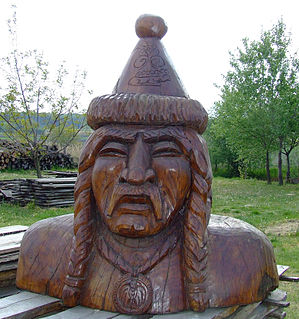 W
WCsanád, also Chanadinus, or Cenad, was the first head (comes) of Csanád County in the Kingdom of Hungary in the first decades of the 11th century.
 W
WDavid of Hungary was a member of the Árpád dynasty as the second son of Andrew I of Hungary and Anastasia of Kiev.
 W
WGerard or Gerard Sagredo was the first bishop of Csanád in the Kingdom of Hungary from around 1030 to his death. Most information about his life was preserved in his legends which contain most conventional elements of medieval biographies of saints. He was born in a Venetian noble family, associated with the Sagredos or Morosinis in sources written centuries later. After a serious illness, he was sent to the Benedictine San Giorgio Monastery at the age of five. He received excellent monastic education and also learnt grammar, music, philosophy and law.
 W
WGéza I was King of Hungary from 1074 until his death. He was the eldest son of King Béla I. His baptismal name was Magnus. With German assistance, Géza's cousin Solomon acquired the crown when his father died in 1063, forcing Géza to leave Hungary. Géza returned with Polish reinforcements and signed a treaty with Solomon in early 1064. In the treaty, Géza and his brother, Ladislaus acknowledged the rule of Solomon, who granted them their father's former duchy, which encompassed one-third of the Kingdom of Hungary.
 W
WGisela of Hungary was the first queen consort of Hungary by marriage to Stephen I of Hungary, and the sister of Henry II, Holy Roman Emperor. She has been beatified by the Roman Catholic Church.
 W
WGrimelda of Hungary was a Hungarian noblewoman and a dogaressa of Venice by marriage to Doge Otto Orseolo. She was the daughter of Géza, Grand Prince of the Hungarians and Princess Sarolt.
 W
WGyula III, also Iula or Gyula the Younger, Geula or Gyla, was an early medieval ruler who apparently ruled in Transylvania. Around 1003, he and his family were attacked, dispossessed and captured by King Stephen I of Hungary (1000/1001-1038). The name "Gyula" also means a title. "Gyula" meant the second highest title in Hungarian tribal confederation.
 W
WHelen of Hungary, also known as Helen the Fair, was a queen consort of Croatia.
 W
WSaint Irene of Hungary, born Piroska, was a Byzantine empress by marriage to John II Komnenos. She is venerated as a saint.
 W
WJudith of Schweinfurt was Duchess consort of Bohemia from 1034 until 1055, by her marriage with the Přemyslid duke Bretislav I.
 W
WLadislas the Bald was a member of the House of Árpád, a grandson of Taksony, Grand Prince of the Hungarians. He is the only known brother of Vazul, a rebellious duke who was blinded on the order of their cousin, King Saint Stephen I of Hungary in 1031 or 1032. Medieval chroniclers, in their effort to conceal that the Kings of Hungary were descended from a prince condemned by the saintly first king, wrote that instead of Vazul, Ladislas was the Hungarian monarchs' forefather. Ján Steinhübel and other modern Slovak historians write that he was Duke of Nyitra under Polish suzerainty, but this theory has not been universally accepted by historians.
 W
WLadislaus I or Ladislas I, also Saint Ladislaus or Saint Ladislas was King of Hungary from 1077 and King of Croatia from 1091. He was the second son of King Béla I of Hungary. After Béla's death in 1063, Ladislaus and his elder brother, Géza, acknowledged their cousin, Solomon as the lawful king in exchange for receiving their father's former duchy, which included one-third of the kingdom. They cooperated with Solomon for the next decade. Ladislaus's most popular legend, which narrates his fight with a "Cuman" who abducted a Hungarian girl, is connected to this period. The brothers' relationship with Solomon deteriorated in the early 1070s, and they rebelled against him. Géza was proclaimed king in 1074, but Solomon maintained control of the western regions of his kingdom. During Géza's reign, Ladislaus was his brother's most influential adviser.
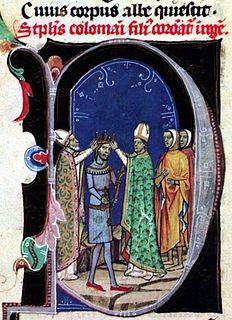 W
WLawrence was a Hungarian prelate at the turn of the 11th and 12th centuries, who served as Archbishop of Esztergom from around 1105 until his death. He was a faithful confidant of Coloman, King of Hungary and the initiator of large-scale church organizational and canon law reforms in the Kingdom of Hungary.
 W
WSaint Maurus of Pécs or Mór was the first known prelate who was born in the Kingdom of Hungary. He was abbot of the Benedictine Abbey of Pannonhalma between around 1029 and 1036, and bishop of Pécs from year 1036 until his death around year 1075. He wrote the Legend of Saints Benedict and Andrew Zorard, two hermits who lived in the region of Nitra in modern-day Slovakia. Maurus's own cult was confirmed by Pope Pius IX in 1848.
 W
WMoses the Hungarian was a Kievan Russian monk of Hungarian origin. He is venerated as a saint on the 26th of July by the Eastern Orthodox Church.
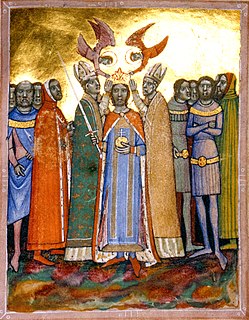 W
WNehemiah was a Hungarian prelate and politician, who served as Archbishop of Esztergom in the 1070s, during the reigns of Géza I and Ladislaus I of Hungary.
 W
WPeter Orseolo, or Peter the Venetian, was King of Hungary twice. He first succeeded his uncle, King Stephen I, in 1038. His favoritism towards his foreign courtiers caused an uprising which ended with his 1041 deposition. Peter was restored in 1044 by Henry III, Holy Roman Emperor. He accepted the Emperor's suzerainty during his second reign, which ended in 1046 after a pagan uprising. Hungarian chronicles are unanimous that Peter was executed by order of his successor, Andrew I, but the chronicler Cosmas of Prague's reference to his alleged marriage around 1055 suggests that he may also have survived his second deposition.
 W
WSamuel Aba reigned as King of Hungary between 1041 and 1044. He was born to a prominent family with extensive domains in the region of the Mátra Hills. Based on reports in the Gesta Hungarorum and other Hungarian chronicles about the non-Hungarian origin of the Aba family, modern historians write that the Abas headed the Kabar tribes that seceded from the Khazar Khaganate and joined the Hungarians in the 9th century.
 W
WSarolt was wife of Géza, Grand Prince of the Hungarians.
 W
WSeraphin was a Hungarian prelate at the turn of the 11th and 12th centuries, who served as Archbishop of Esztergom from around 1095 until his death.
 W
WSolomon, also Salomon was King of Hungary from 1063. Being the elder son of Andrew I, he was crowned king in his father's lifetime in 1057 or 1058. However, he was forced to flee from Hungary after his uncle, Béla I, dethroned Andrew in 1060. Assisted by German troops, Solomon returned and was again crowned king in 1063. On this occasion he married Judith, sister of Henry IV, Holy Roman Emperor. In the following year he reached an agreement with his cousins, the three sons of Béla I. Géza, Ladislaus and Lampert acknowledged Solomon's rule, but in exchange received one-third of the kingdom as a separate duchy.
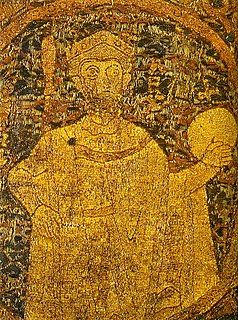 W
WStephen I, also known as King Saint Stephen, was the last Grand Prince of the Hungarians between 997 and 1000 or 1001, and the first King of Hungary from 1000 or 1001, until his death in 1038. The year of his birth is uncertain, but many details of his life suggest that he was born in, or after, 975, in Esztergom. At his birth, he was given the pagan name Vajk. The date of his baptism is unknown. He was the only son of Grand Prince Géza and his wife, Sarolt, who was descended from a prominent family of gyulas. Although both of his parents were baptized, Stephen was the first member of his family to become a devout Christian. He married Gisela of Bavaria, a scion of the imperial Ottonian dynasty.
 W
WSwanhilde of Ungarnmark was an Austrian royal consort as Margravine of Austria.
 W
WVazul, or also Vászoly, was a member of the House of Árpád, a grandson of Taksony, Grand Prince of the Hungarians. Otherwise, the only certain information of his life, that he was kept in captivity and blinded in the fortress of Nyitra in the last years of the reign of his cousin, King Stephen I of Hungary. Modern historians, including György Györffy, do not exclude that he had earlier been Duke of Nyitra. He is the forefather of nearly all Kings of Hungary who reigned after 1046.